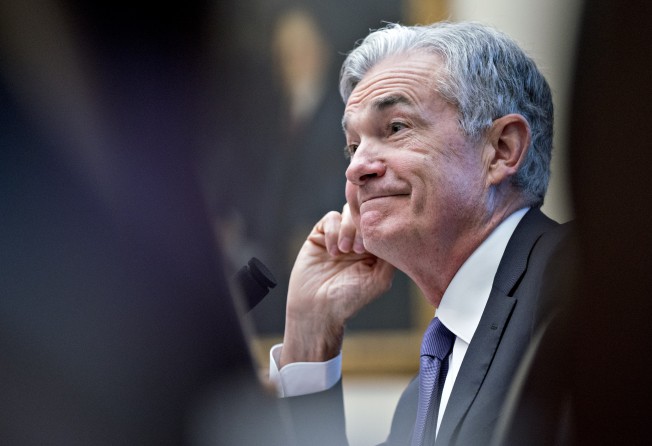Powell’s caution signals the Fed is prepared for a U-turn in interest rate hikes
Nicholas Spiro says the Fed chairman is keeping faith with monetary tightening while the US economic outlook remains bright, but his stark warning on protectionism could pave the way for a change of course. For the trigger, watch the Treasury yield curve

Is a hawkish US Federal Reserve on a collision course with an increasingly vulnerable global economy?
This is a question which Fed chairman Jerome Powell did his best to skirt around when he appeared before Congress earlier this week to testify and answer questions about the conduct of monetary policy.
When Powell took the reins of the Fed in early February, there was a strong case for a faster pace of interest rate increases. Not only had Congress just given America’s economy a huge fiscal boost by passing a US$1.5 trillion tax cut, wage growth had accelerated to its fastest pace since 2009, suggesting that a tight labour market was finally beginning to fuel inflationary pressures.
Fast forward five months, and the case for tighter monetary policy remains compelling. A key gauge of consumer prices reached nearly 3 per cent last month, above the Fed’s 2 per cent inflation target. Data published on Monday revealed that US retail sales rose for the fifth straight month in June, providing a fillip to growth which could have been as high as 4.5 per cent last quarter.
Yet, while America is leading the global expansion, the Fed’s job has become a lot harder since tensions over global trade began to escalate in April.
Watch: The US-China trade war escalates
On Monday, the International Monetary Fund sounded the alarm by warning in an update that rising trade tensions “could derail the recovery and depress medium-term growth prospects”. The following day, Bank of America Merrill Lynch published the results of its latest fund manager survey showing that investor sentiment is increasingly bearish and that a trade war is viewed as the greatest risk facing markets since the euro-zone debt crisis in 2012.
Powell himself acknowledged these threats in his remarks to Congress, pointing out that worries about protectionism were starting to affect business confidence, and going so far as to say that “there’s no precedent for this kind of broad trade discussions in my adult life”. Yet, despite the Fed’s evident concern about the mounting risks to the US economy, Powell said that, “for now”, the US central bank would push ahead with its plans to tighten policy further, which include reducing the size of its bloated balance sheet.
While stock markets took heart from Powell’s confidence that the US economy is resilient enough to warrant additional rate hikes, the fact that the Fed is now making further tightening conditional on an easing of trade tensions shows the extent to which the economic outlook has dimmed in the past few months.

Bond markets have been signalling that the Fed is overly hawkish and will have to halt (and possibly reverse) its rate-hiking cycle in 2020. The much-discussed flattening of the Treasury yield curve – while yields on short-dated bonds are rising sharply as the Fed increases rates, their long-dated equivalents are relatively stable, suggesting there is limited scope for further tightening – indicates there is a significant risk of a Fed policy mistake.
For emerging markets, which are at the sharp end of the removal of stimulus, the growing uncertainty over US monetary policy is a double-edged sword. On the one hand, the strain on the asset class is likely to persist in the near term as the Fed continues to tighten policy. The US dollar began climbing again this week, putting further pressure on the battered currencies of developing economies.
However, the recent fall in the benchmark 10-year Treasury yield, which has plunged by 25 basis points since mid-May to 2.8 per cent, could be the canary in the coal mine.
Watch: Trade tariffs leave Chinese consumers unhappy
A full-blown trade war, the mere threat of which has already contributed to a slowdown in Europe and China, is likely to have more of a deflationary impact than an inflationary one. This could push the 10-year yield down further, causing the curve to invert – historically a reliable indicator of a downturn. Several Fed policymakers believe the Fed should not tempt fate by allowing the curve to flip.
The more markets fret about a trade war, the bigger the risk of an inverted curve and the greater the pressure on the Fed to turn more dovish.
Right now, only 26 basis points separate the yield on 10-year Treasuries from its two-year equivalent – the lowest gap since 2007. The betting is that the spread will turn negative, possibly as soon as early next year. If this happens, it could be the trigger for the Fed to refrain from tightening policy further.
The note of caution sounded by Powell this week could yet pave the way for a dovish U-turn from the Fed.
Nicholas Spiro is a partner at Lauressa Advisory